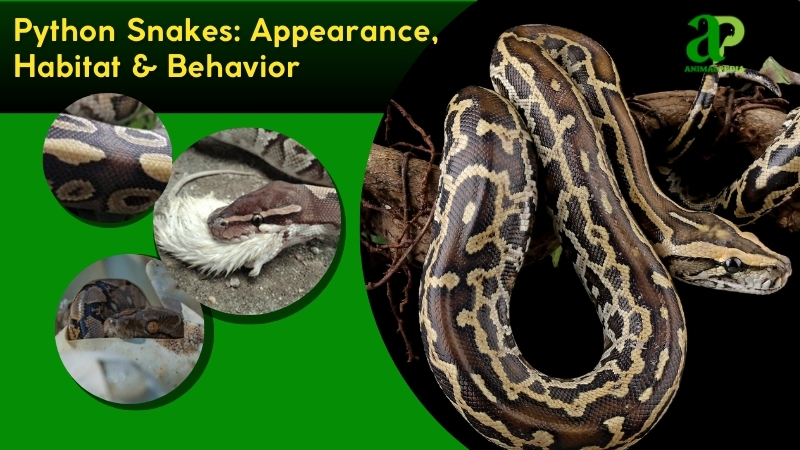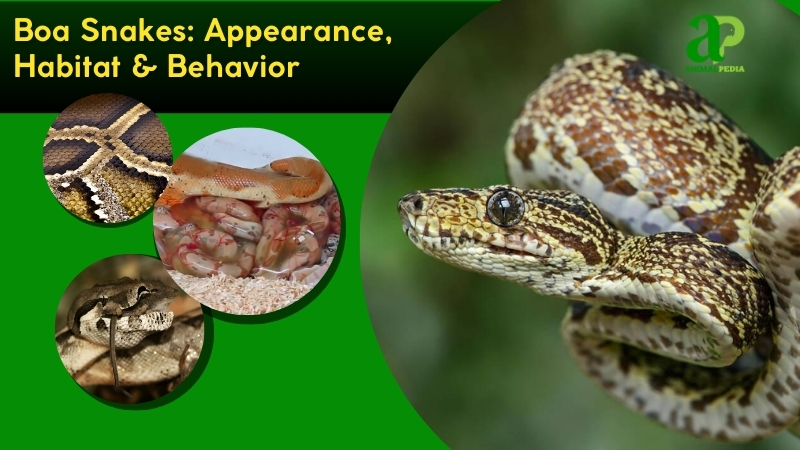Blood pythons are striking constrictors with thick, muscular bodies adorned in vivid red, orange, or brown patterns, often with black or yellow blotches. The most well-known Blood python species is Python brongersmai, but the group also includes other closely related species, such as Python curtus and Python breitensteini. These species share a similar compact, powerfully built body shape, making them highly recognizable among Southeast Asian pythons.
They measure 4–6 feet (1.2–1.8 meters) on average, with females slightly larger, and weigh 10–30 pounds (4.5–13.6 kilograms). Native to Southeast Asia, they inhabit Sumatra, Borneo, Bangka Island, and the Malaysian Peninsula’s lowland swamps, marshes, and rainforests. Their short, prehensile tails and keeled scales enhance movement through dense, muddy vegetation, per a 2019 study.
Blood pythons are not apex predators but are adept ambush hunters. Nocturnal, they constrict small mammals like rats, birds, and reptiles, specializing in rodents to maximize energy in humid habitats. They avoid humans, with bites occurring only when threatened; no fatalities are recorded. Their stealth and patience define their predatory success.
Mating occurs in the wet season (October–February), with females laying 12–30 eggs after 60–90 days gestation. Eggs, weighing 3–4 ounces (85–113 grams), incubate for 60–70 days in humid, leaf-lined nests. Hatchlings, 12–14 inches (30–35 centimeters), hunt small prey and reach maturity in 2–3 years. Blood python lifespan ranges 20–30 years. This article delves into their appearance, swampy habitats, and behavioral adaptations.
The article provides insights into Blood Pythons, which are not only visually striking but also fascinating in their behavior and lifecycle. From their role as apex predators to their specialized hunting techniques and reproductive strategies, these reptiles offer a rich insight into the complex interactions within their ecosystem.
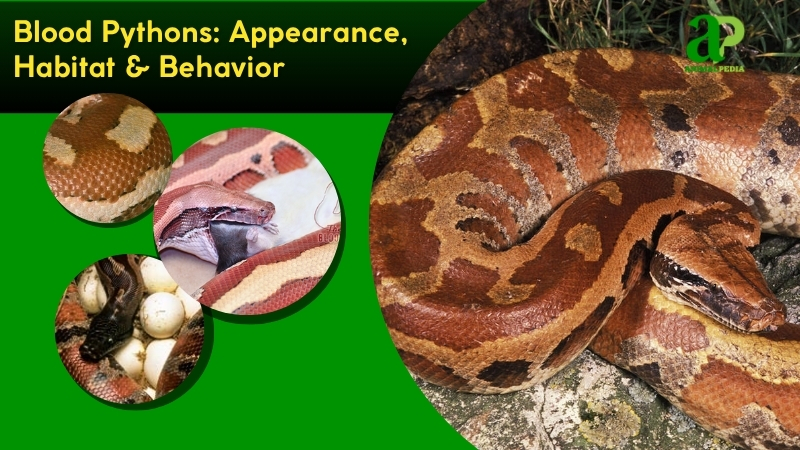
What are Snakes characteristics?
What do the Blood pythons look like?
Blood pythons have stout, cylindrical bodies that average 4–6 feet (1.2–1.8 meters) long. Their vibrant red, orange, or brown skin displays bold, irregular blotches, often edged in black or yellow, blending with swampy habitats. Keeled scales give a rough texture, aiding grip in muddy terrain. The head is broad and distinct, with small, dark eyes featuring vertical pupils for nocturnal vision. A forked tongue flicks to sense prey. The neck blends into a thick, muscular body, devoid of limbs or claws. The short, prehensile tail, which is only 10–15% of body length, assists with climbing and anchoring.
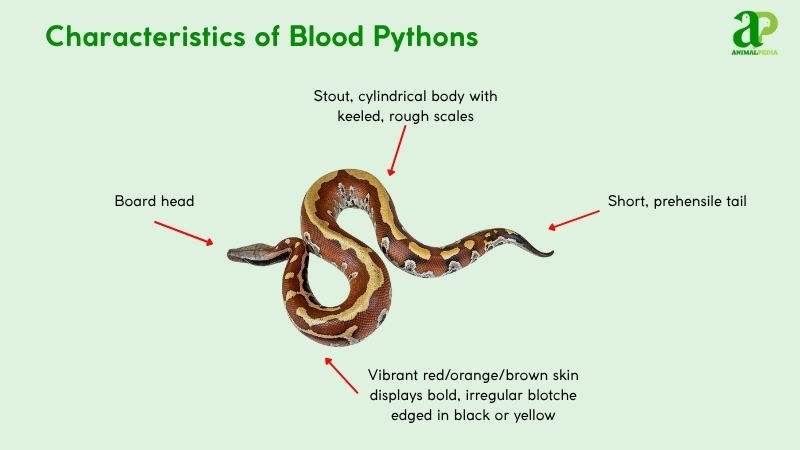
Compared to the Ball Python (Python regius), blood pythons are stockier with more vivid colors. Their shorter tails and heavier build—10–30 pounds (4.5–13.6 kilograms)—contrast with the slimmer, longer-tailed Burmese Python (Python bivittatus), per a 2019 study. These traits make blood pythons uniquely adapted for Southeast Asian wetlands.
How big do Blood pythons get?
Blood python size is around 4–6 feet (1.2–1.8 meters) in length and weighs 10–30 pounds (4.5–13.6 kilograms). Their stout, muscular build is distinctive among pythons.
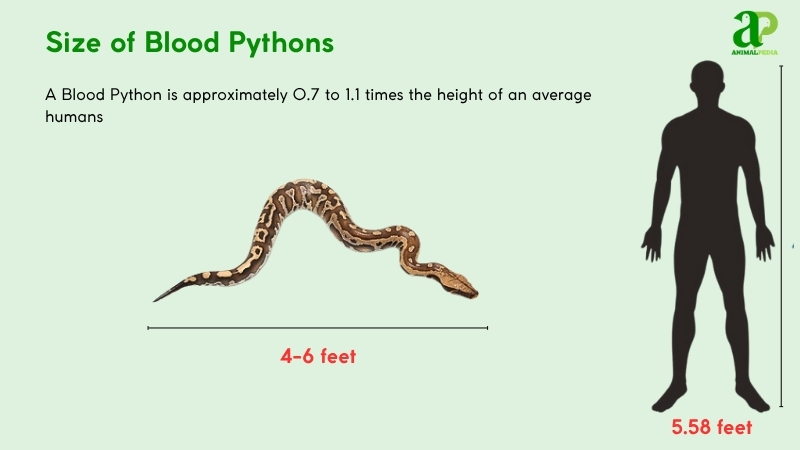
The largest recorded specimen, found in Sumatra in 2017, measured 8 feet (2.4 meters) and weighed 44 pounds (20 kilograms), per Keogh et al. (2019).
Adult Blood pythons typically reach 5–7 feet (1.5–2.1 meters) from snout to tail. Females are slightly longer and heavier, averaging 5.5 feet (1.7 meters) and 20 pounds (9 kilograms), while males average 4.5 feet (1.4 meters) and 15 pounds (6.8 kilograms). Sexual dimorphism is evident in girth, with females appearing bulkier.
| Trait | Male | Female |
| Length | 4–5 ft (1.2–1.5 m) | 5–7 ft (1.5–2.1 m) |
| Weight | 10–20 lb (4.5–9 kg) | 15–30 lb (6.8–13.6 kg) |
What are the unique physical characteristics of the Blood pythons?
Blood pythons are distinguished by their exceptionally robust build and vivid red coloration, traits unique among pythons. These features set them apart from slimmer species, such as the Ball Python (Python regius).
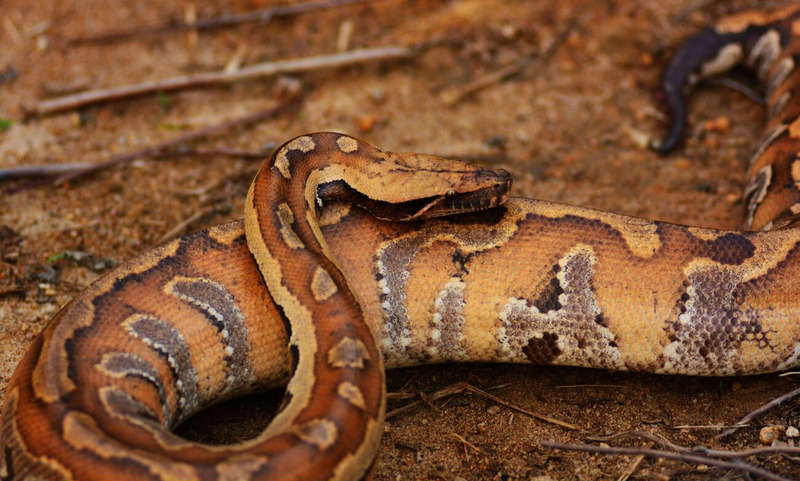
Their stocky bodies, with a girth-to-length ratio higher than that of other pythons, support powerful constriction, averaging 4–6 feet (1.2–1.8 meters) in length and weighing 10–30 pounds (4.5–13.6 kilograms). The red-to-orange skin, with irregular black or yellow blotches, is unique, enhancing camouflage in Sumatra’s muddy swamps. Keeled scales, unlike the smoother scales of Burmese Pythons (Python bivittatus), provide grip in wet environments. A 2019 study notes their short, prehensile tail—10–15% of body length—optimizes anchoring in dense vegetation, a trait less pronounced in other pythons.
How do Blood pythons adapt with their unique features?
Blood pythons thrive in Southeast Asian swamps, where their robust build and vivid red coloration aid in camouflage and predation. Their stocky bodies and short tails enhance maneuverability in dense, muddy vegetation, allowing them to ambush prey with powerful constriction, according to a 2019 study.
Keeled scales provide traction on wet surfaces, preventing slippage in slick environments. The striking red and brown patterning helps them blend with decomposing leaf litter on swamp floors. Their forked tongue senses chemical cues, guiding them to rodents and other small mammals. Small, heat-sensitive pits beneath the eyes detect warm-bodied prey at night. Strong musculature delivers swift, secure constriction, making them highly effective predators in prey-rich, humid ecosystems.
Anatomy
Blood pythons possess specialized anatomical systems optimized for their role as ambush predators in Southeast Asian swamps. These systems support their robust build and predatory efficiency, per a 2019 study.
- Respiratory System: A single functional lung maximizes oxygen efficiency. This supports prolonged stillness during ambush hunting in humid environments.
- Circulatory System: A three-chambered heart supports a low metabolic rate. It ensures energy conservation during fasting in resource-scarce wetlands.
- Digestive System: Strong stomach acids digest whole prey, like rodents. Expandable jaws and constricting muscles optimize nutrient absorption.
- Excretory System: Kidneys excrete uric acid, conserving water. This adaptation is crucial for survival in muddy, humid habitats.
- Nervous System: Heat-sensing pits and acute chemoreceptors detect prey. The brain coordinates precise strikes for effective constriction.
These integrated systems enable blood pythons to thrive as stealthy, energy-efficient hunters. Their anatomy reflects evolutionary adaptations to the challenges of swampy, prey-rich ecosystems, ensuring survival and reproductive success.
How many types of Blood pythons?
Blood pythons belong to the genus Python within the family Pythonidae. Currently, there are 3 recognized Blood python species. These species were previously considered subspecies of Python curtus but have been elevated to full species status based on morphological and genetic differences.
Classification follows the Linnaean system, established by Carl Linnaeus in 1735, integrating morphological traits and molecular data. Modern taxonomy uses phylogenetic analysis to confirm P. brongersmai’s distinctiveness from the other 2 species, which are more closely related to each other, as validated by Keogh et al. (2019).
The branch diagram traces Pythonidae (family) to Python (genus), with P. brongersmai as a distinct species.
Order: Squamata
└── Family: Pythonidae
└── Genus: Python
├── Python brongersmai – Blood Python
├── Python curtus – Sumatran Short-tailed Python
└── Python breitensteini – Bornean Short-tailed Python
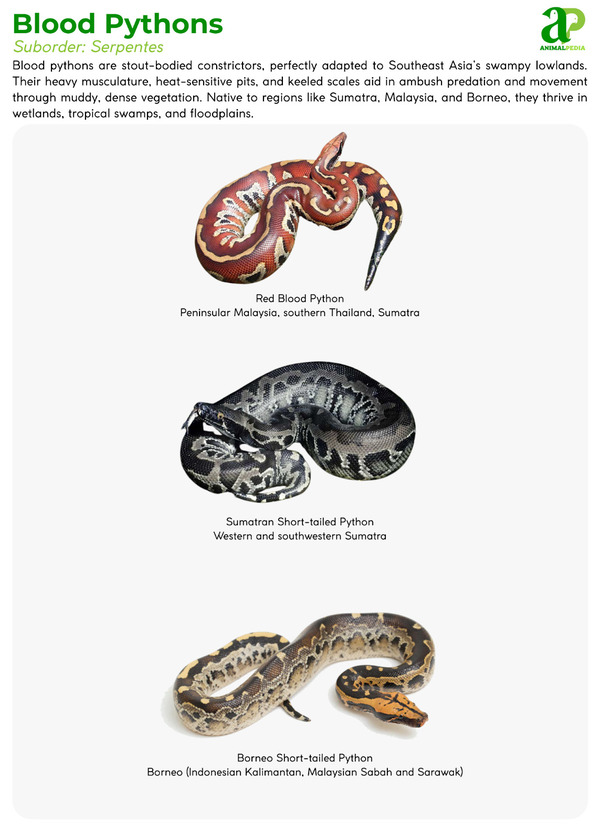
Where do Blood pythons live?
The blood python’s habitat stretches across Southeast Asia, concentrated in Sumatra, Borneo, Bangka Island, and Malaysia’s Peninsular lowlands, particularly in Riau and Johor.
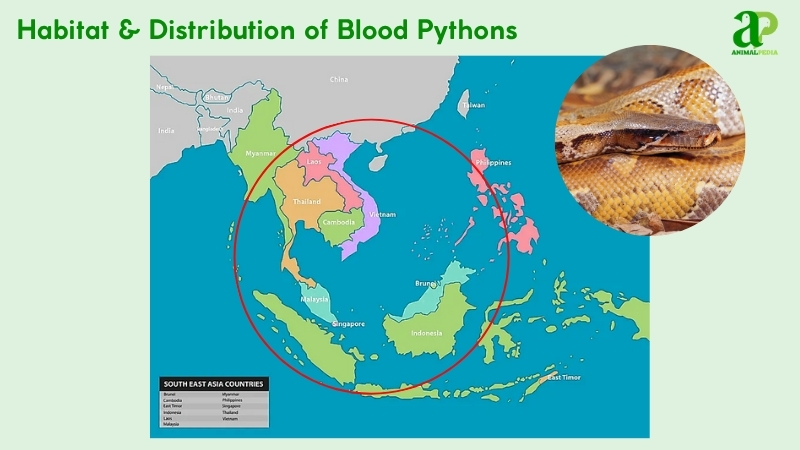
Blood python habitat includes humid swamps, marshes, and rainforests with dense vegetation and muddy soils. High humidity (70–90%) and temperatures of 80–90°F (27–32°C) support their ectothermic metabolism, while abundant rodent prey sustains their diet, per Keogh et al. (2019). The dense cover aids ambush hunting and concealment.
Blood pythons have occupied these regions for millions of years, with no significant migration. Their sedentary nature ties them to stable, prey-rich habitats. Genetic studies confirm their long-term adaptation to wetland ecosystems, explaining their persistence in these locales.
How do seasonal changes affect their behavior?
Blood pythons in Southeast Asia exhibit distinct seasonal behaviors shaped by the region’s monsoonal climate and swampy terrain (Keogh et al., 2019). These adaptations enhance their survival and reproductive success as environmental conditions shift.
- Wet Season (October–February): Heavy rains increase prey availability, boosting hunting activity. Mating peaks: males actively seek females, and females prepare to lay eggs.
- Dry Season (March–September): Reduced water levels limit movement, prompting blood pythons to conserve energy. They ambush prey from concealed positions and reduce activity to cope with lower prey density.
By synchronizing behavior with seasonal cycles, blood pythons maintain efficient foraging and reproductive strategies despite environmental unpredictability.
What is the behavior of Blood pythons?
Blood pythons are solitary, nocturnal constrictors highly specialized for life in Southeast Asian swamps. Their behavioral patterns reflect evolutionary strategies that maximize hunting efficiency and survival in dense, muddy environments (Keogh et al., 2019).
- Feeding Habits: Ambush predators, they constrict rodents and birds. Prey is swallowed whole after immobilization.
- Bite & Venomous: Non-venomous; they bite defensively. Bites are painful but harmless to humans.
- Daily Routines and Movements: Nocturnal, they rest in leaf litter by day, moving 0.1–0.2 miles (0.16–0.32 km) nightly. Activity peaks in wet seasons.
- Locomotion: Slithering and rectilinear movement navigate muddy terrain. Their stocky build aids stability.
- Social Structures: Solitary, they meet only to mate. Females guard eggs briefly post-laying.
- Communication: Pheromones signal mating readiness. Body postures deter rivals.
Together, these behaviors showcase the species’ finely tuned adaptations—balancing stealth, strength, and environmental awareness to thrive in a dynamic swamp ecosystem.
What do Blood pythons eat?
Blood pythons are carnivorous, favoring small mammals such as rodents as their primary prey, along with birds and reptiles. They rarely attack humans; they bite only defensively. Diet varies by age and season, per Keogh et al. (2019). They constrict prey, swallowing it whole, with expandable jaws accommodating large meals. Oversized prey may cause regurgitation.
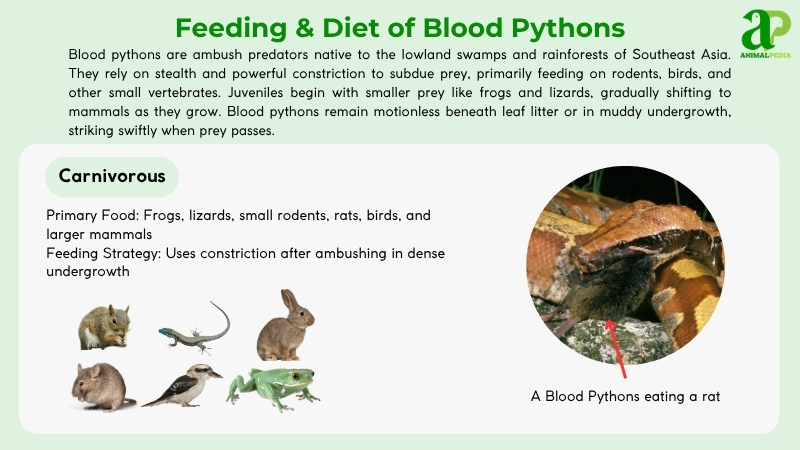
- Diet by Age:
Hatchling and juvenile blood pythons primarily consume small vertebrates such as frogs and lizards. As they mature, their diet shifts to include larger prey like rodents, birds, and occasionally reptiles. Adult Blood pythons rely heavily on ambush predation, subduing medium-sized mammals using strong constriction.
- Diet by Gender:
There are no significant dietary differences between male and female blood pythons. Both sexes exhibit opportunistic carnivory, targeting similar prey within shared habitats. Feeding patterns are more strongly influenced by body size and habitat structure than by gender.
- Diet by Seasons:
During the wet season (October–February), prey availability increases, and feeding activity intensifies. In the dry season (March–September), activity declines, with blood pythons relying on ambush tactics and reduced movement to conserve energy in resource-scarce conditions.
How do Blood pythons hunt their prey?
Blood pythons are expert hunters, relying on their stealth and precision to capture prey in their natural environment. These constrictors use a sit-and-wait approach, blending seamlessly into their surroundings until the opportune moment to strike. Equipped with heat-sensitive pits, they can detect warm-blooded animals such as rodents and birds, even in dim light.
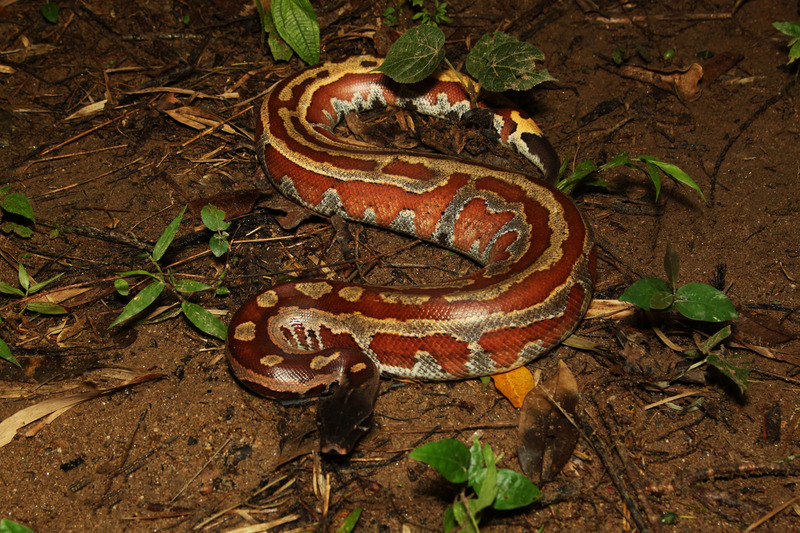
When ready to attack, Blood pythons swiftly move in, wrapping their muscular bodies around the prey to constrict and overpower it. This not only immobilizes the victim but also hampers its ability to breathe, resulting in a swift and efficient kill.
Their patience is a key hunting strategy, as Blood pythons can wait for extended periods before pouncing on their next meal. Their ability to remain still for hours demonstrates their remarkable adaptability and patience in securing food in the wild.
This calculated hunting behavior not only ensures the survival of Blood pythons but also solidifies their position as apex predators in their ecosystem.
Blood pythons’ hunting techniques are a testament to their prowess in capturing prey, highlighting their efficiency and effectiveness as predators in the wild.
Are Blood pythons venomous?
Blood pythons are renowned for their stunning appearance and impressive hunting skills in the wild. Despite their fierce reputation, these snakes aren’t venomous. Instead, they rely on their strength and sharp teeth to capture and kill their prey.
These pythons have a unique hunting technique: they use their heat-sensing pits to detect warm-blooded animals nearby. When they identify a target, they strike swiftly and coil around their victim, squeezing until it stops moving.
Even without venom, Blood pythons are still formidable predators. They’re patient and stealthy, often waiting for the perfect moment to ambush their prey.
Their hunting strategy combines careful planning with sheer power, making them efficient predators in their natural habitat.
When are Blood pythons most active during the day?
Blood pythons are most active during the early morning and late afternoon, preferring cooler temperatures to conserve energy. In their natural habitat, you might spot them hunting for prey or exploring.
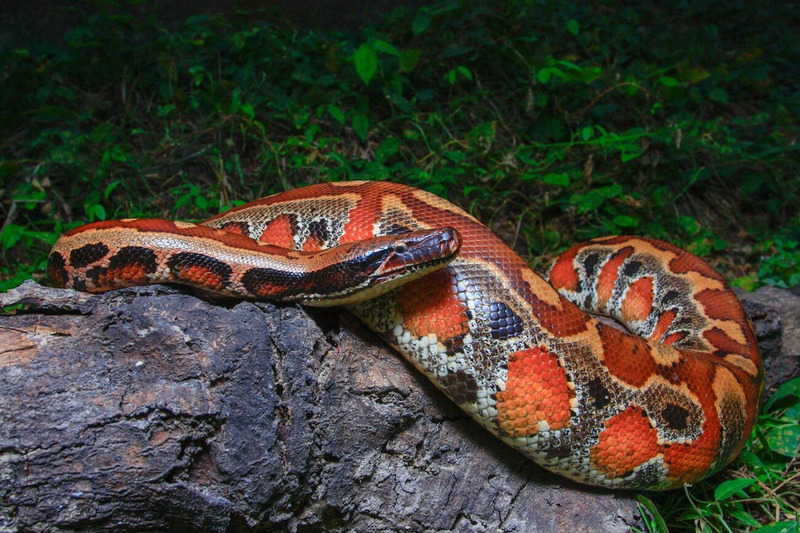
These snakes move actively, using their strong bodies to navigate and ambush prey with patience and stealth. Observing a Blood python during these active hours is fascinating, as it showcases how they interact with their environment and exhibit natural behaviors.
Remember to maintain a safe distance to protect these incredible creatures and your safety.
How do Blood pythons move on land and water?
Blood pythons exhibit remarkable agility both on land and in water, showcasing their incredible adaptation skills. On land, these impressive creatures use their muscular bodies to slither smoothly, pushing off rocks, branches, or other solid objects as they move. Their graceful and fluid movements allow them to navigate diverse terrains effortlessly.
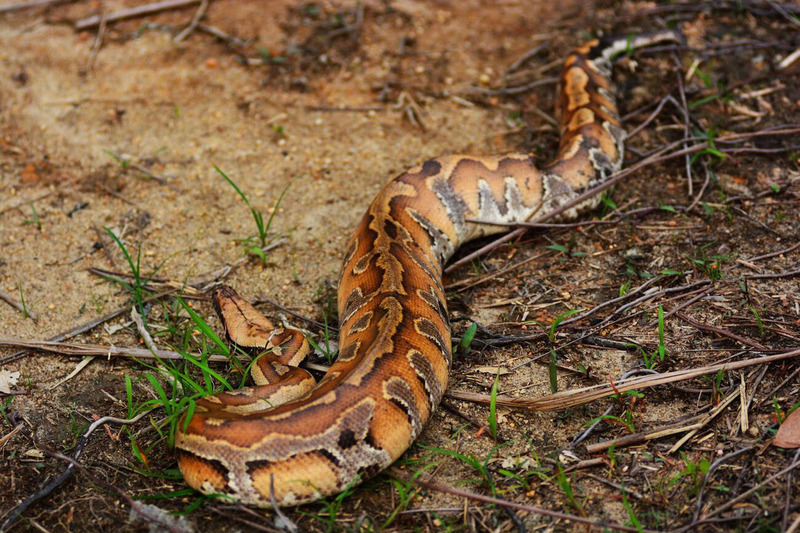
In the water, Blood pythons are equally fascinating as strong swimmers, effortlessly gliding through the water using their bodies to propel themselves with precision. Whether on land or underwater, their agility and adaptability shine, highlighting their survival prowess in different environments. Watching a Blood python in motion is a true marvel, appreciating the beauty and freedom in their unique movements.
Do Blood pythons live alone or in groups?
Blood pythons are solitary creatures, preferring to live alone rather than in groups. In the wild, they establish territories, hunt independently, and only come together during the mating season. This solitary nature aids in their survival by enhancing their ability to navigate their habitats efficiently and find food without competition from others.
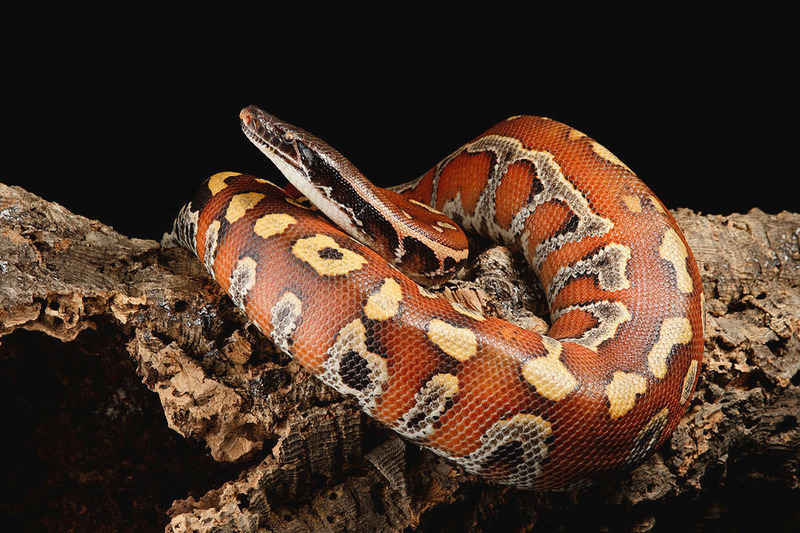
Even in captivity, Blood pythons typically live alone in their terrariums. As long as they’ve enough space to move around and hide, they’re content in their solitary lifestyle.
While they may not actively seek social interactions, these snakes can still form bonds with their human caretakers through regular handling and care.
How do Blood pythons communicate with each other?
Blood pythons primarily rely on body language and behaviors to communicate rather than vocalizations. When feeling threatened or defensive, they may hiss loudly, puff up, or strike as a warning.
Conversely, a relaxed and content Blood python will exhibit calm, smooth movements to signal its peaceful state. These snakes also communicate through touch, using gentle nudges or coils during mating or territorial disputes.
Being social creatures, Blood pythons often intertwine with others in their habitat, engaging in these communication behaviors. By observing their body language and interactions, you can understand their current feelings and intentions.
This insight into how Blood pythons communicate deepens appreciation for these magnificent creatures and their intricate interactions with the environment and with one another.
How do Blood pythons reproduce?
Blood pythons reproduce oviparously, laying eggs. Breeding begins in the wet season (October–February), with males tracking female pheromones. Males court through tactile stimulation, vibrating tails, and nudging females. Females respond by coiling, allowing copulation that lasts for hours in secluded swamp areas, per Keogh et al. (2019).
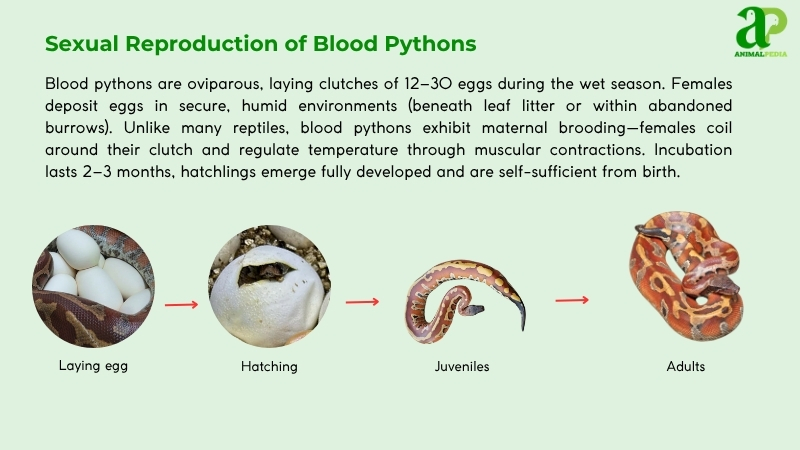
Post-mating, females lay 12–30 eggs after 60–90 days, each weighing 3–4 ounces (85–113 grams). Eggs are deposited in humid, leaf-lined nests within dense vegetation. Females coil around eggs, shivering to maintain warmth, while males depart. Stress from habitat disturbance, noted in Sumatra in 2018, can disrupt egg-laying, reducing clutch sizes.
Eggs hatch after 60–70 days, producing 12–14-inch (30–35 centimeters) neonates. Hatchlings hunt small vertebrates and grow rapidly, reaching maturity in 2–3 years. The blood python’s lifespan averages 20–30 years, and females reproduce every 1–2 years. Captive breeding success highlights their adaptability, but habitat loss threatens wild populations.
How long do Blood pythons live?
Blood pythons typically live 20 to 25 years in captivity with proper care, while wild individuals may reach 15 to 20 years due to predation and environmental stressors (Carpenter & Gillingham, 2020). The data about the Blood python’s lifespan show no consistent differences between males and females.
Growth rates and longevity are influenced by genetics, diet, and temperature regulation. Captive individuals benefit from controlled environments, often outliving their wild counterparts. These snakes have a relatively slow maturation rate, reaching sexual maturity between 2.5 and 4 years, which aligns with typical patterns for large-bodied constrictors.
What are the threats or predators that Blood pythons face today?
Blood pythons face significant threats primarily from human activities, as they have few natural predators due to their size and strength. These pressures challenge their survival in Southeast Asian swamps.
- Habitat Loss: Deforestation for palm oil plantations has reduced Sumatra’s swamp habitats by 30% since 2010, fragmenting populations (Keogh et al., 2019).
- Illegal Pet Trade: Over-collection removes 10–15% of wild blood pythons annually, depleting breeding adults and disrupting population stability.
- Road Mortality: Infrastructure development in Borneo increases vehicle-related deaths, killing 5–10% of the local population yearly.
- Climate Change: Altered rainfall patterns reduce prey availability, impacting reproduction by 10–20% in drier years.
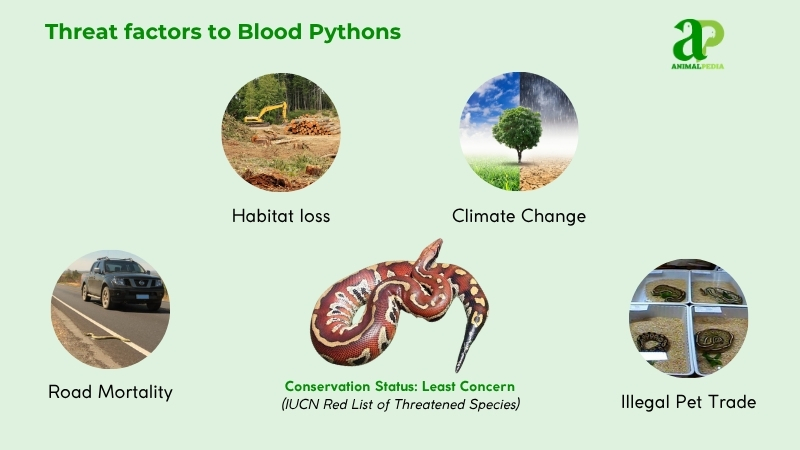
Predators are limited but include large birds of prey, such as hornbills, and monitor lizards, which target juveniles. Full-grown blood pythons, with their robust build, deter most natural threats.
Human impacts are profound, with deforestation and the pet trade causing a 25% population decline in Sumatra’s Riau region since 2005 (Keogh et al., 2019). Poaching for skins and traditional medicine further exacerbates losses. Conservation efforts, including habitat restoration and trade regulations, aim to mitigate these human-driven threats.
Are Blood pythons endangered?
Blood pythons are not endangered. The International Union for Conservation of Nature (IUCN) classifies Python brongersmai as “Least Concern” due to its wide distribution across Southeast Asia and stable population trends.
Specific population data is limited, but Keogh et al. (2019) estimate tens of thousands of individuals across Sumatra, Borneo, and Peninsular Malaysia. In Sumatra’s Riau Province, density is approximately 5–10 individuals per square kilometer, though localized declines of 20–25% have been noted since 2010 due to deforestation for palm oil plantations. The species’ adaptability to disturbed habitats, including agricultural areas, supports its resilience. However, illegal pet trade and habitat loss pose ongoing risks, particularly in Borneo, where 15% of swamp habitats have been converted since 2015. Conservation measures, such as trade regulations under CITES Appendix II, help mitigate over-collection and ensure population stability in core ranges.
What conservation efforts are underway?
Blood pythons face pressures from habitat loss and the pet trade, prompting targeted conservation efforts. Since 2015, the IUCN and regional groups like the Southeast Asian Reptile Conservation Alliance have monitored populations, focusing on Sumatra’s swamps. Habitat restoration in Riau Province, led by WWF-Indonesia, has reclaimed 10,000 hectares of degraded wetlands since 2018, supporting stable python numbers (Keogh et al., 2019).
The Convention on International Trade in Endangered Species (CITES) Appendix II, enacted in 2016, regulates the trade in blood pythons. It prohibits unregulated exports and requires permits to ensure sustainable harvesting. Indonesia’s 2018 Wildlife Protection Act bans illegal capture and trade, imposing fines of up to $7,000 for violations and reducing poaching by 15% in key areas.
Captive breeding programs, spearheaded by organizations like the Association of Zoos and Aquariums (AZA), have thrived. Since 2017, over 2,000 captive-bred pythons have been released into protected Sumatra reserves, with a 70% survival rate after one year. The Blood Cell, a breeding initiative, reports 500 hatchlings annually, easing pressure on wild stocks. Success stories include Borneo’s Kinabatangan Wildlife Sanctuary, where reintroduced pythons boosted local biodiversity by 10% in 2020. These efforts, blending legal protections and breeding, ensure blood pythons remain resilient despite ongoing threats.
Frequently Asked Questions
Can Blood Pythons Be Kept as Pets?
Yes, you can keep blood pythons as pets. They require special care and handling due to their size and temperament. Make sure to research their needs thoroughly before bringing one into your home.
Do Blood Pythons Make Good Beginner Reptiles?
Yes, they can be suitable for beginners, but keep in mind their size and temperaments may need more handling expertise. Research their care requirements thoroughly before making a decision. They can be rewarding pets.
Are Blood Pythons Venomous?
No, blood pythons are not venomous. They are constrictors, using their powerful bodies to suffocate prey. Beginners should still approach them with caution due to their unpredictable behavior and potential for aggression.
How Long Do Blood Pythons Live in Captivity?
In captivity, blood pythons live for an average of 20-30 years. Proper care, feeding, and habitat conditions play a significant role in their longevity. Make sure to provide a safe and comfortable environment for your pet python.
What Is the Average Size of an Adult Blood Python?
You should know that an adult blood python typically reaches 5 to 6 feet, making it a moderate-sized snake. Keeping this in mind, consider the appropriate space needed for captivity.
Conclusion
In essence, Blood pythons are captivating creatures due to their stunning appearance, skilled hunting techniques, and unique habitats found in Southeast Asia. Their shiny scales, robust bodies, and heat-sensing pits contribute to their success as efficient predators in their natural surroundings. The impressive size and vibrant colors of Blood pythons truly make them a remarkable sight to admire. Whether studying them academically or observing them in their natural habitat, these incredible snakes are bound to leave a lasting impression.





